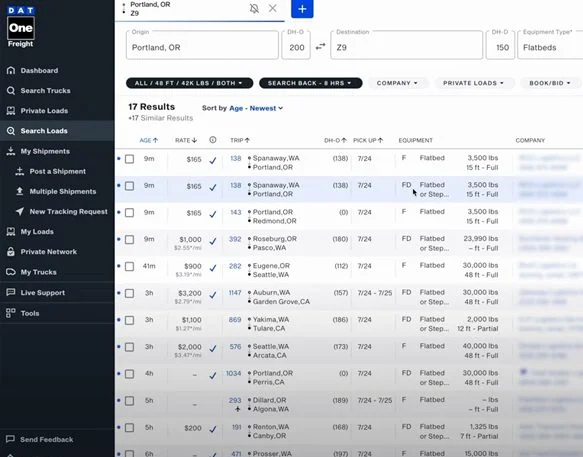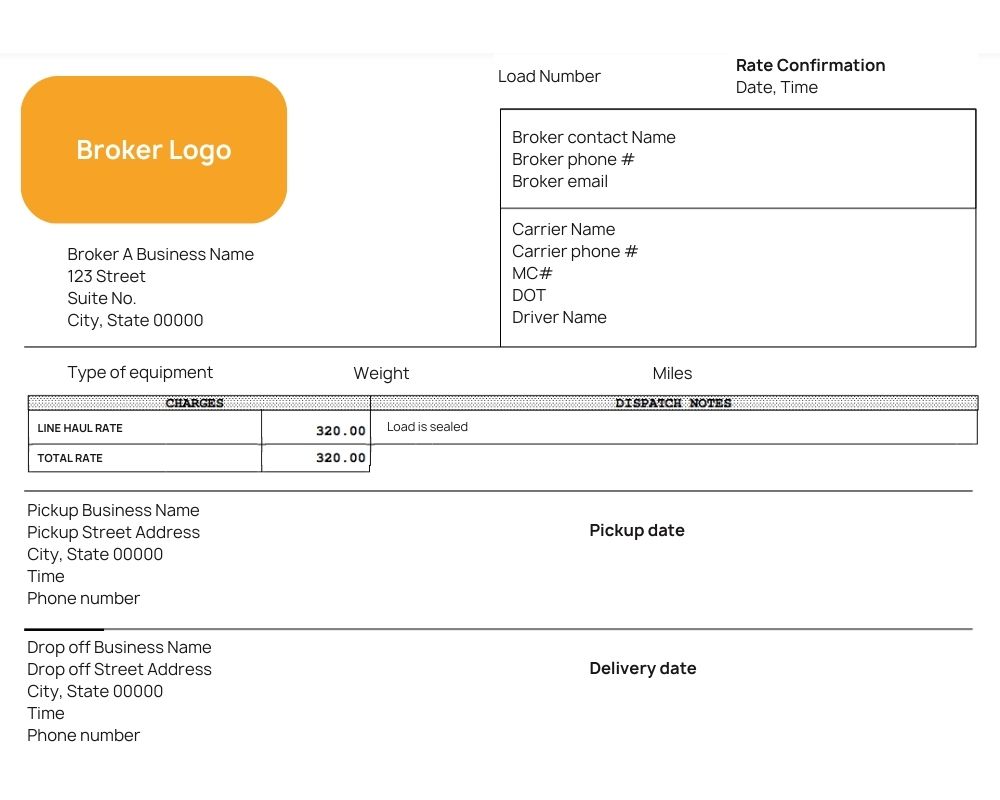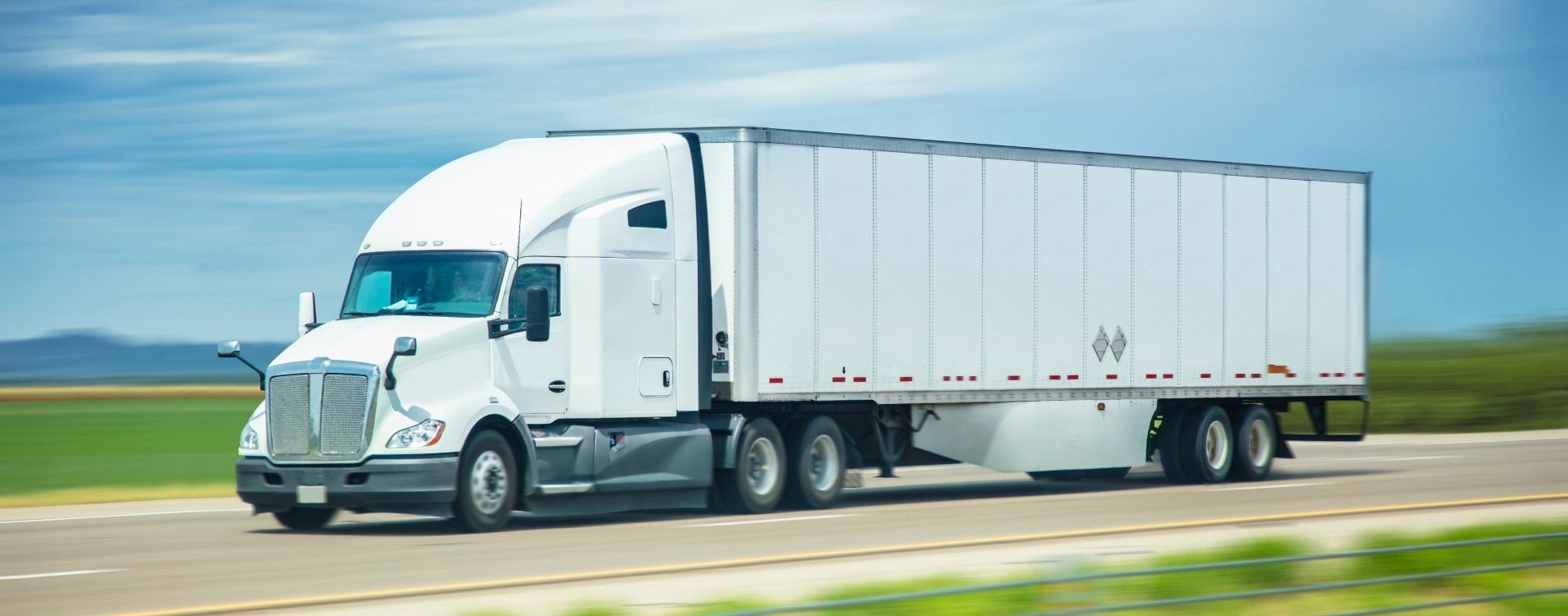Booking The First Load With A New Authority
Booking loads for a new trucking authority can be challenging. First, not many brokers want to work with brand-new trucking companies because they don’t yet have a track record for reliability and safety. Second, if you’re new to the business, the number of options, data, and pressure to book can be overwhelming.
But hey, that’s why we’re here! In this article, we’re going to walk you through how you’ll go about booking the first load for your trucking company.
If you’re short on time, we wrote a mobile-friendly guide on how to book loads with a new authority. Click here to download it now.
The basics of booking loads
Let’s start with some vocabulary:
- Carrier: trucking company or motor carrier. That’s you! You have the truck.
- Shipper: the business that needs the freight moved. They have the product.
- Broker: the business that finds the trucks for the shipper. They are your customer.
- Load boards: where brokers and carriers find each other. Brokers post the loads and carriers bid on those loads. This is the place where you’ll start to build relationships with brokers to eventually get access to contracts and dedicated lanes.
- Dispatcher: the person who finds freight for a motor carrier. They might be your employee or an external service provider.
Brokers that work with new authorities
Most brokers will only work with carriers that have been operating for 6-12 months, but not all. Here are some brokers that have been known to work with new authorities:
- CH Robinson
- Total Quality Logistics (TQL)
- Knight Transportation
- Lipsey Logistics
- Online Freight
- KCH Transportation
- Freight Management
You can sign up for a call with one of our factoring account executives to get a complete list of brokers who work with new authorities.
Resource Alert: We created an interactive checklist for new carriers to help you organize your business. Click here to get it sent to your inbox.
How to book loads with a new authority
Some brokers, like CH Robinson, have their own load boards. If not, you can use load boards like DAT, Trucker Path, and 123loadboard.
Related article: What Is A Load Board, And How Does It Help Your Trucking Business?
When you get to the load board, here are some general guidelines you can follow:
Search
Start by looking for loads leaving your current area. This is called the load’s “origin” and is where you’ll pick it up.
Then filter for your type of truck (flatbed, reefer, dry van, etc.). Not all boards have loads for all types of trucks and some have a separate section for box trucks.

Depending on the load board, you’ll see different details: origin, destination, pickup time, weight, distance, and rate. Unfortunately, not all load boards will have the rate posted. This is where it’s important to understand your cost per mile so that you know how much profit you’ll make on each load.
Related article: How to Calculate Your Cost Per Mile
Para maximizar tu tarifa por milla, necesitarás saber qué áreas son “calientes” y “frías”, es decir, dónde las tarifas son más altas y cuál será la tendencia para esa semana. Las tarifas cambian de un día a otro y de una zona a otra, dependiendo del volumen de carga disponible y la cantidad de camiones en esa área, así como de otros factores.
Pro Tip: DAT offers products that show maps of different freight markets and some load boards may suggest routes to maximize your profitability.
When you find a load you want, first check the broker’s credit rating. This is an indication of how reliable the broker is and how likely they are to pay you.
Negotiate
Some boards allow you to book directly, but it is best practice to call the broker and try to negotiate the rate up.
When you have someone on the phone, below are some questions you’ll want to get answered. Remember: you’re negotiating from the moment they pick up the phone!
- Is this load still available? This will give you an idea of their urgency to move the load.
- Can you confirm the pickup and delivery dates and times? Always confirm. Brokers sometimes make mistakes when posting loads.
- Are the locations first-come-first-serve or appointment based? This will indicate how long you have to wait to get loaded/unloaded.
- I’m seeing that the weight is listed as X lb, is that correct? More weight = more fuel.
- Do you pay accessorial, a loading or unloading fee?
- What about detention? How will detention be handled and reported?
- Can you do [10% higher than the amount you want to be paid for the load]?
As the carrier, you want to ensure:
- You have the right equipment for this load
- You have the right insurance
- The broker is a reputable business: ask how long they’ve been operating and check their credit rating.
Related resource: Virtual Workshop Recording on How to Negotiate Better Rates with Brokers
Some brokers will only want to communicate by email. If that’s the case, here’s an email template you can use:
Good morning/afternoon! My name is [your name], from [your company name], MC[MC number].
I’m looking at load [load #] going from [origin] to [destination].
[Add any additional questions you have about the load]
Can you do [10% higher than the amount you want to be paid for the load]?
Thank you,
Sometimes the person you’re talking to will be able to give you an answer right away, but other times they will need to check with the client (the shipper) or a manager. If they’re interested in working with you, they’ll either come back with a counteroffer or they’ll approve the rate you quoted.
It’s very likely that you will not get the first load you try. Just remember, there are always more loads for you!
Confirm
Then if you decide to take the load, they’ll send you a rate confirmation (AKA “rate con”) with the agreed rate. Make sure you check this. Your phone/email conversation means nothing if the rate confirmation is not correct.
Don’t move an inch until you get the rate confirmation. This document will have the broker’s name, logo, and contact info, as well as the load number and rate. The load is not confirmed until you have this document.

Even if the broker says they will send it to you “soon”, if you head out to get the load before getting the rate confirmation, there’s a risk that you will deadhead miles and not get confirmed at all.
When you get the rate confirmation, make sure the information matches the broker’s and your information exactly. Unfortunately, there are fraudsters out there that will take advantage of new carriers.
Your first time working with a broker, they will request that you complete a carrier packet. Generally, this means they will send you a link to onboard you into their system. It will include providing documentation:
- An agreement between you and the broker
- Your operating authority
- A W-9 signed and dated
- A direct deposit form or notice of assignment for factoring
- Certificate of insurance (ask your insurance company for this)
They may also ask you for other information about your business like the number of drivers and types of trucks you have. This is a good sign! It means they want to know more about your availability for the future.
Onboarding into a new broker’s system can take a few days, so do this as soon as humanly possible. Even if you have a factoring service, you will not get paid until you’re onboarded with the broker.
Repeat!
Next, you’ll want to book a load coming back with the origin as the destination of the first load and the pickup on the day the first one is delivered. This will keep you moving and allow time to book the next loads.
After booking your last load for the week, try booking one more load for Monday. While most of the trucking industry works on Saturdays, brokers and shippers may not. The farther ahead you can plan, the better for your business!
Start booking early in the morning if you’re on the west coast. Remember, you’re 3 hours behind the brokers on the East Coast. You don’t want to be rolling out of bed a full two hours after they’ve arrived in their offices.
How to get paid for your first load
When you deliver a load to its destination, you’ll get the BOL signed. This and the rate confirmation are the two most important documents. They prove that you did indeed deliver the load and should be paid for it.
You have a couple of different options when it comes to getting paid: collect from the broker, use the broker’s quick pay, and factoring.
If you collect from the broker, you will get paid the full amount. However, brokers’ payment terms vary widely from one week to 1-2 months. Unless you have a lot of cash savings, it will be very difficult if not impossible to keep up with expenses if you only collect directly from brokers on their payment terms.
Some brokers offer quick pay, meaning they will pay for the load in 1-3 days for a fee. The terms on quick pay vary greatly from broker to broker and not all brokers offer quick pay.
Factoring is a financial service that buys your invoices from you at a discounted rate and then collects the full payment from the brokers. Factoring services also vary greatly in speed, customer service, and user experience.
Factoring with Bobtail means no long-term contracts and no hidden fees. It also means same or next-day payment, the best customer service in the industry, and a super easy-to-use mobile app for submitting invoices.




